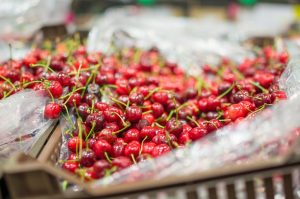Chilean cherry exports to spike as mid-season varieties enter the mix

The Chilean cherry industry may have run into some problems this season with rail and hail, but improved weather conditions have helped the campaign progress with good and consistent fruit quality. 
Speaking to www.freshfruitportal.com, Carlos Tapia, technical director at cherry research company Avium, said the campaign had been running seven to 10 days earlier than last year.
"This means that the bulk of the Royal Dawn and Brooks volumes have finished, and for the earliest growing regions the harvest of the Santina variety is now fully underway with excellent production, color and fruit quality," he said.
As for the Lapins variety, he estimated the harvest could kick off in the early regions between Nov. 20-25, while Bing would likely be picked a few days later.
"I think that the season will continue to run early by about a week or five days," he said, adding total industry production this year is expected to be more than 20 million boxes.
Industry exports are to start to increase over the coming week, and Tapia expected high volumes in late November or early December. He also explained the season would not necessarily end earlier than last year as production had expanded further south in the country.
The Asian market began receiving Chilean cherries from the start of November, mainly the Royal Dawn and Santina varieties. The fruit was reported to be fetching very high prices.
The fruit had a strong performance in China's Singles' Day on Nov. 11 - a major shopping period in the country.
The Chilean Fruit Exporters Association (ASOEX) collaborated with e-retailers Alibaba and Frutacloud to carry out promotions, and Frutacloud reported the fruit became the highest-grossing item in the fresh produce category.
"Our effort demonstrates that there is a genuine and growing demand for premium produce on Alibaba’s Tmall platform", Fruta Cloud CEO George Liu said in a release.
"ASOEX’s marketing message really resonates with our customers. I think it’s a bold and effective campaign that helps Chilean Cherries build strong brand recognition and loyalty in the minds of the growing upper middle class."
Chilean grower adapts to harsh conditions
Adverse weather conditions like rain and frosts during the key growing periods of September and October are a common problem for producers in much of the country, but one company is working to allay the effects of Mother Nature.
Curico-based Frutland Chile, which exports all of its cherries to Shanghai-based import partner Grandfruit, is installing collapsible roofs above its trees to avoid supply disruptions. Nearly half of the trees are now covered. 
"The roofs are in use from the first week of September, when the trees bear fruit, to Sept. 25, so as to reduce the possibility of damage the frost can bring to these fruits." commercial manager Eduardo Espinosa Toro told www.frehsfruitportal.com.
"After Sept. 25 we will collapse these roofs and will only use them in the event of rain to prevent these fruits from sprouting roots or have their skins damaged."
The company is boosting production of the Regina variety, which Toro said was the most popular among Chinese consumers.
Grandfruit president Kant Lee said while Chinese consumers had been more discerning of cherry quality over recent year, sweet varieties undoubtedly remained their favorite.
"In that respect, the Regina cherries which are sweeter and harder are the most popular ones," he said.
Demand for cherries in China is rising by around 20% annually, but Lee said retail prices had stayed relatively consistent.
While Grandfruit has so far only sold Chilean cherries on the local Chinese market, plans are afoot to move further afield.
"The Chinese market is definitely the biggest for the cherries we import, but our company will be looking into new business models such as joint growing and joint retailing with partners, as well as expanding into other Asian markets such as Thailand, Korea, Japan and Taiwan," he said.
Photo: www.shutterstock.com









































